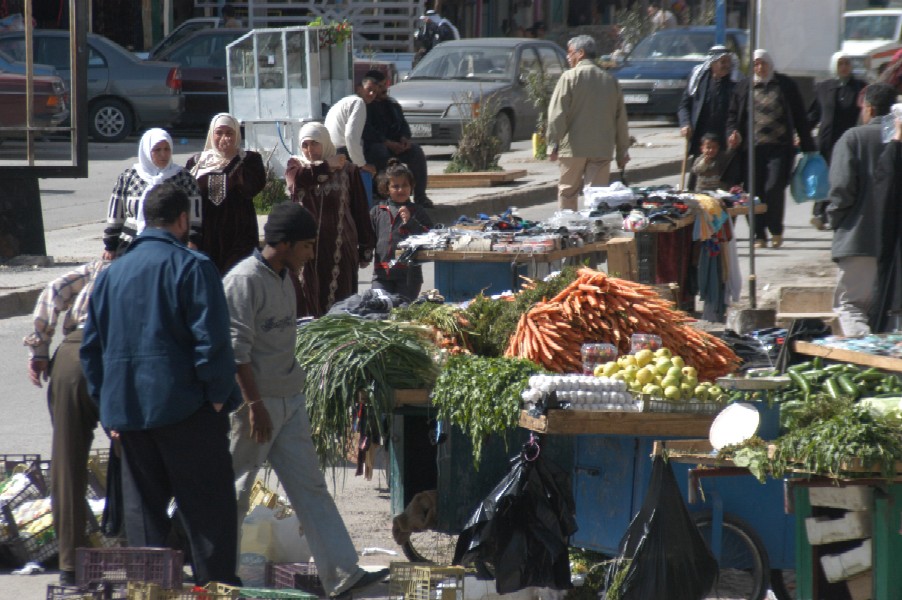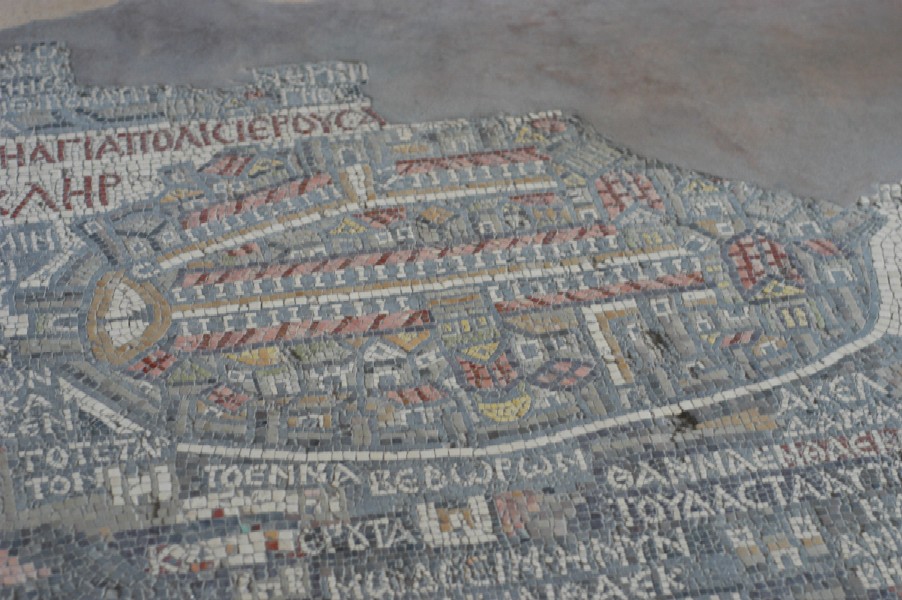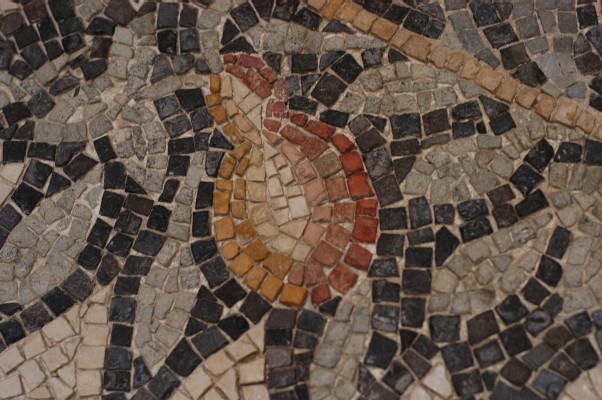February 25. AMMAN "Day Trip to Madaba" Feeling that we had taken enough down time in the past couple of days we motivated ourselves to make a day trip to nearby Madaba. It was easy enough to catch a bus at  Abdali station, just downstairs from our hotel. People pointed us in the direction of the right bus queue and we hopped on to secure a seat. There weren't any schedules. The buses just left when they were full. Rob jumped off to grab a couple of those tasty Jordanian coffees for the ride. It was a mid-sized bus and pretty comfortable for the one hour ride out to Madaba. Abdali station, just downstairs from our hotel. People pointed us in the direction of the right bus queue and we hopped on to secure a seat. There weren't any schedules. The buses just left when they were full. Rob jumped off to grab a couple of those tasty Jordanian coffees for the ride. It was a mid-sized bus and pretty comfortable for the one hour ride out to Madaba.
Madaba is home to a concentration of Jordanian Christians but it has had a long and tumultuous history. It was first mentioned in the Old Testament as having been conquered, along with the rest of Moab, by the Iraelites, but was later won back by Moab in the middle of the 9th century BC. It later passed through from the Greeks to the Jewish to the Nabateans before ending up as part of the Roman Empire. By 451 Christianity was well established in Madaba and they even had their own bishop. Mosaic work, which started over a century earl ier, really flourished under emperor Justinian in 527-65, and led to the fantastic works of art that have survived to this day. When the Persians and later the Muslims conquered Madaba the people were left to freely practice their religion and mosaics continued to be built as late as 785. Madaba was abandoned during the Mumluke period and was untouched until 1879 when Christian and Muslim conflict forced Catholic and Orthodox families into exile in the Madaba region. The Ottoman government allowed them to build churches again but restricted them to sites where churches had existed before and in 1884 the fabulous mosaic map of the Holy Land was uncovered, followed by others in the Madaba area. ier, really flourished under emperor Justinian in 527-65, and led to the fantastic works of art that have survived to this day. When the Persians and later the Muslims conquered Madaba the people were left to freely practice their religion and mosaics continued to be built as late as 785. Madaba was abandoned during the Mumluke period and was untouched until 1879 when Christian and Muslim conflict forced Catholic and Orthodox families into exile in the Madaba region. The Ottoman government allowed them to build churches again but restricted them to sites where churches had existed before and in 1884 the fabulous mosaic map of the Holy Land was uncovered, followed by others in the Madaba area.
Like the Byzantine mosaic floor of the basilica in Petra the mosaics in Madaba displayed scenes of Christian symbols like lamb and the fish, personifications of the sea, the earth and the seasons, flora and fauna, and animal life. In a time when illiteracy was wide-spread the mosaics helped to teach people the bible pictorially. The artists used pattern-books that were compiled in cultural capital, especially the Byzantine capital of Constantinople. However, in 726 the Byzantine emperor declared the use of icons forbidden throughout his empire because they were too close to pagan worship. And, since the Prophet Mohammad (622) the Muslim world was taught that God is the only creator and that creating images of human beings, and even animals, was blasphemous. So, the Umayyad caliph (719-24) issued a directive to have all depictions of people destroyed. Sadly, this led to the destruction of many mosaic works. The mosaicists replaced images with blank tiles or jumbled the tiles into an unrecognizable cloud-like form. Those that survived did so only because they were already buried by time. After 120 years the Christians ban was removed but the Muslim restriction remains to this day.
When we arrived in Madaba the town was not very impressive in itself but was a pleasant place with friendly people. We stopped at the market near the bus station and were greeted by the shop owner and a woman shopping in the store. She was buying some roasted seeds and offered us one to try. They tasted like pumpkin seeds. She proceeded to pick up a couple of candy bars off of the counter and offer those to us as well but we politely declined. The owner was apparently her brother-in-law so she was offering up his goods as her own. He made no protest and tried to make conversation with us. It made Rob a bit uncomfortable when the man told him that he had a nice wife but after this many weeks in Egypt and Jordan we started to understand that it is meant more as a compliment to the husband than to the wife. greeted by the shop owner and a woman shopping in the store. She was buying some roasted seeds and offered us one to try. They tasted like pumpkin seeds. She proceeded to pick up a couple of candy bars off of the counter and offer those to us as well but we politely declined. The owner was apparently her brother-in-law so she was offering up his goods as her own. He made no protest and tried to make conversation with us. It made Rob a bit uncomfortable when the man told him that he had a nice wife but after this many weeks in Egypt and Jordan we started to understand that it is meant more as a compliment to the husband than to the wife.
The main attraction of Madaba, the Church of the Map, wasn't very far from the bus station and we were greeted by a number of people as we walked through town. In Jordan the phrase "Welcome to Jordan!" usually meant just that and was not a precursor to trying to scam you. The Church of the Map, also known as the Church of St. George, was a simple looking Greek Orthodox church from the outside but inside a large part of the floor was covered in tile work. The bits had been carefully covered with pieces of carpets or had been cordoned off so people didn't walk on them. It was a fabulous map of the Holy Land. We could make out Jerusalem, Bethlehem, the Dead Sea and the Nile and other parts of the region. It had been done with impressive accuracy. The more remote bits in other parts of the church showed just haw large the mosaic had been at one time.
From the church we passed by a couple of carpet shops owned by very nice men, one of which kindly offered us a small cup of coffee as we entered his shop. From the shops we visited a small archeological site with a handful of mosaics and remnants of the old Roman road. A larger archeological site a few blocks away had a longer piece of the same road and mosaics displayed from a few different churches as well as examples of non-religious mosaic works. The large  Hippolytus Hall was the most interesting of the bunch because it was a combination of tile work from the original lavish private home that stood on the grounds and the tile work of the church that covered the home entirely a century later. Now mosaics from both are visible and make an interesting contrast to one another. In the mosaics from the private home there was a humorous image of a bare-breasted Aphrodite sitting next to Adonis, spanking a winged cupid with a sandal. Hippolytus Hall was the most interesting of the bunch because it was a combination of tile work from the original lavish private home that stood on the grounds and the tile work of the church that covered the home entirely a century later. Now mosaics from both are visible and make an interesting contrast to one another. In the mosaics from the private home there was a humorous image of a bare-breasted Aphrodite sitting next to Adonis, spanking a winged cupid with a sandal.
The last mosaic we visited in Madaba was the large Church of the Apostles, a 24m by 15m basilica with adjacent side chapels, the floors of which were all covered in mosaics. It dated back to 568 and is a real gem of Madaba mosaic art. The center image featured a lovely personification of the sea in which a woman was depicted emerging from the waves with fish, sharks and sea monsters surrounding here. From this last church we made our way over to the small Madaba museum which offered a simple display of folk costumes, archeological finds and a model of a traditional home. It served mostly as a nice resting place for us. The patio overlooked part of the town and the under the nice blue sky it was a nice place to sit.
Down the hill from the museum we passed a colorful little shop selling a myriad of girly things from hair clips to scarves but the thing that caught my eye was the Buffy the Vampire Slayer image of Sarah Michelle Gellar that was incorporated into the stores sign. Leaving Buffy we walked a few blocks down and went up to the hill at the center of town.  We were starving at this point and wanted a place to eat a late lunch. The restaurant we were searching for, a highly acclaimed gourmet restaurant serving traditional food, wasn't open but its more informal tavern counterpart was open for business. We ordered a hearty collection of food that included grilled kebabs, goat cheese in thyme, tabbouleh salad, deliciously thick hummus served with pine nuts, grilled halloum cheese, mushroom stuffed with cheese, and sambousek (fried dumplings filled with meat). We left the restaurant very happily gorged on probably the best meal we'd eaten since leaving home. We were starving at this point and wanted a place to eat a late lunch. The restaurant we were searching for, a highly acclaimed gourmet restaurant serving traditional food, wasn't open but its more informal tavern counterpart was open for business. We ordered a hearty collection of food that included grilled kebabs, goat cheese in thyme, tabbouleh salad, deliciously thick hummus served with pine nuts, grilled halloum cheese, mushroom stuffed with cheese, and sambousek (fried dumplings filled with meat). We left the restaurant very happily gorged on probably the best meal we'd eaten since leaving home.
We caught a bus back to Amman but neglected to ask which station the bus was headed for and we inadvertently ended up at Raghadan Station. According to our map it should have been easy to walk to the center of town from the station but none of the landmarks made sense. We were just going to take a cab but the first cab we hopped in wanted JD10 which was about 20 times the price. We must have been walking along with a lost look in our faces when a young Palestinian couple asked if we needed help. When we said we needed to get to Abdali station they said they were going the same way and they would take us. They were going via service taxi, white  colored taxis that ran specific routes and were shared among different passengers. The cost was much less for one person than a regular taxi and you could go farther. As we walked to the service taxi station the young man walked with Rob while his girlfriend dropped back to walk with me. That was the way people were socially segregated in Jordan. She didn't speak a great deal of English but did a nice job of introducing herself and asking a few questions. The four of us filled cab and they wouldn't even let us pitch in our share of the cab fare. We even suspected that they weren't really going to Abdali Station and took a detour just to make sure that we got where we needed to go. When we got out of the cab they waived good-bye and headed on their way. We thanked them and wondered too late what we could have done to reciprocate. I thought that maybe we should have asked them into the hotel for tea but they did seem to be heading somewhere and didn't linger like they expected an offer. It was just a random act of kindness that makes you feel like you are in a special place. colored taxis that ran specific routes and were shared among different passengers. The cost was much less for one person than a regular taxi and you could go farther. As we walked to the service taxi station the young man walked with Rob while his girlfriend dropped back to walk with me. That was the way people were socially segregated in Jordan. She didn't speak a great deal of English but did a nice job of introducing herself and asking a few questions. The four of us filled cab and they wouldn't even let us pitch in our share of the cab fare. We even suspected that they weren't really going to Abdali Station and took a detour just to make sure that we got where we needed to go. When we got out of the cab they waived good-bye and headed on their way. We thanked them and wondered too late what we could have done to reciprocate. I thought that maybe we should have asked them into the hotel for tea but they did seem to be heading somewhere and didn't linger like they expected an offer. It was just a random act of kindness that makes you feel like you are in a special place.
|
GREECE
Athens
Jan 27-Feb 4
EGYPT
Cairo
Feb 4
Feb 5
Feb 6
Feb 7
Aswan
Feb 8
Feb 9
Feb 10
Luxor
Feb 11
Feb 12
Feb 13
Feb 14
Feb 15
Nuweiba
Feb 16-17
JORDAN
Petra
Feb 18
Feb 19
Feb 20
Feb 21
Amman
Feb 22
Feb 23-24
Feb 25
Feb 26
Feb 27
Feb 28
Feb 29-Mar 1
Dead Sea
Mar 2
Mar 3
ISRAEL
Eilat
Mar 4
EGYPT
Cairo
Mar 5
Mar 6
Mar 7
Mar 8
GREECE
Athens
Mar 9
Santorini
Mar 10
Mar 11
Mar 12-13
Crete
Mar 14
Mar 15-16
Mar 17-21
Athens
Mar 22
|

